Organizational Behaviour at Sainsbury: Culture, Motivation, and Teamwork
VerifiedAdded on 2023/06/14
|13
|4218
|250
AI Summary
This report analyzes the organizational behaviour at Sainsbury, including its culture, politics, power, and motivation techniques. It also evaluates the benefits of teamwork and different theories that influence behaviour and achieve organizational goals. The report recommends using the McClelland need theory and goal setting theory to enhance the working environment and radiate positivity. The Tuckman Team Model and Belbin Team Role Theory are critically analyzed to evaluate the development of cooperation in teams.
Contribute Materials
Your contribution can guide someone’s learning journey. Share your
documents today.
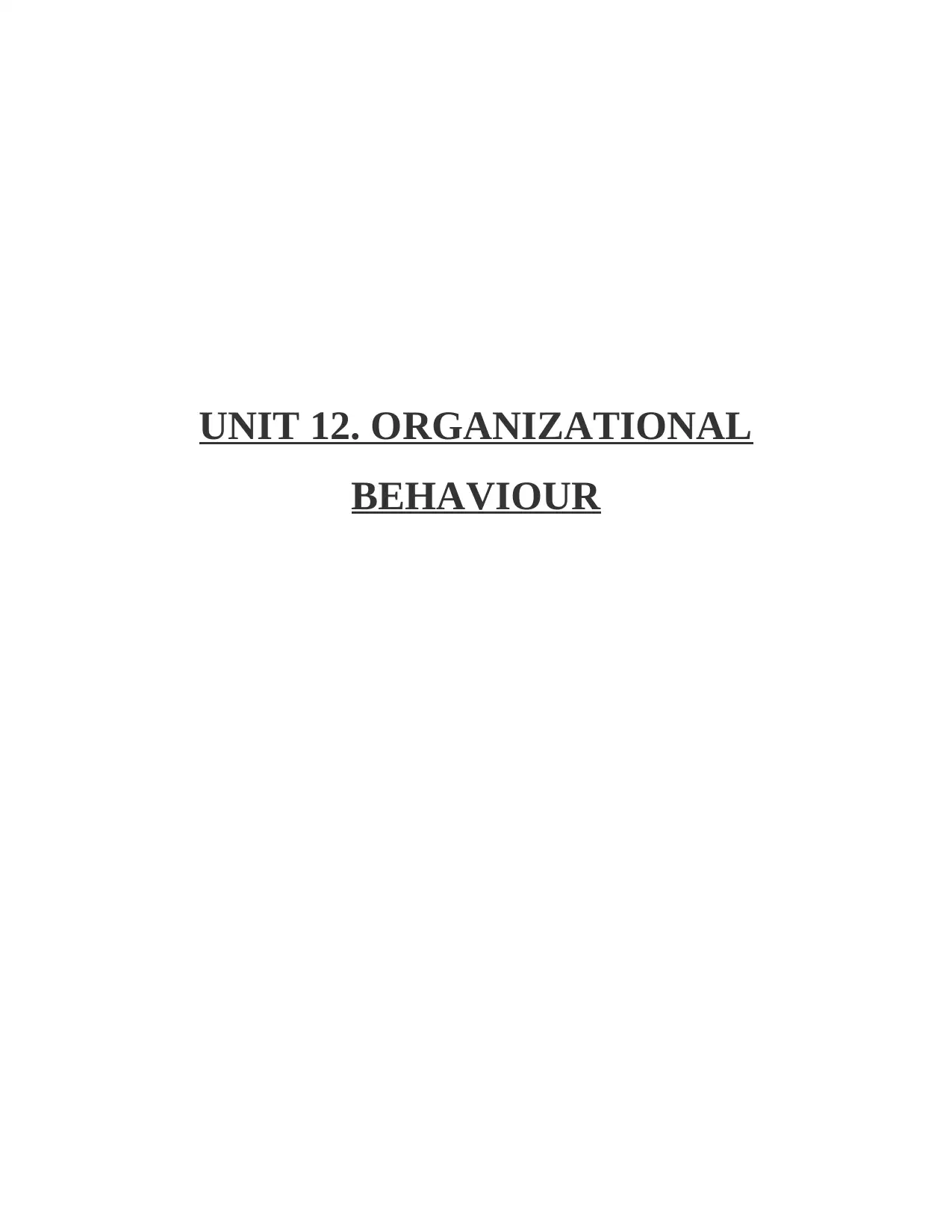
UNIT 12. ORGANIZATIONAL
BEHAVIOUR
BEHAVIOUR
Secure Best Marks with AI Grader
Need help grading? Try our AI Grader for instant feedback on your assignments.
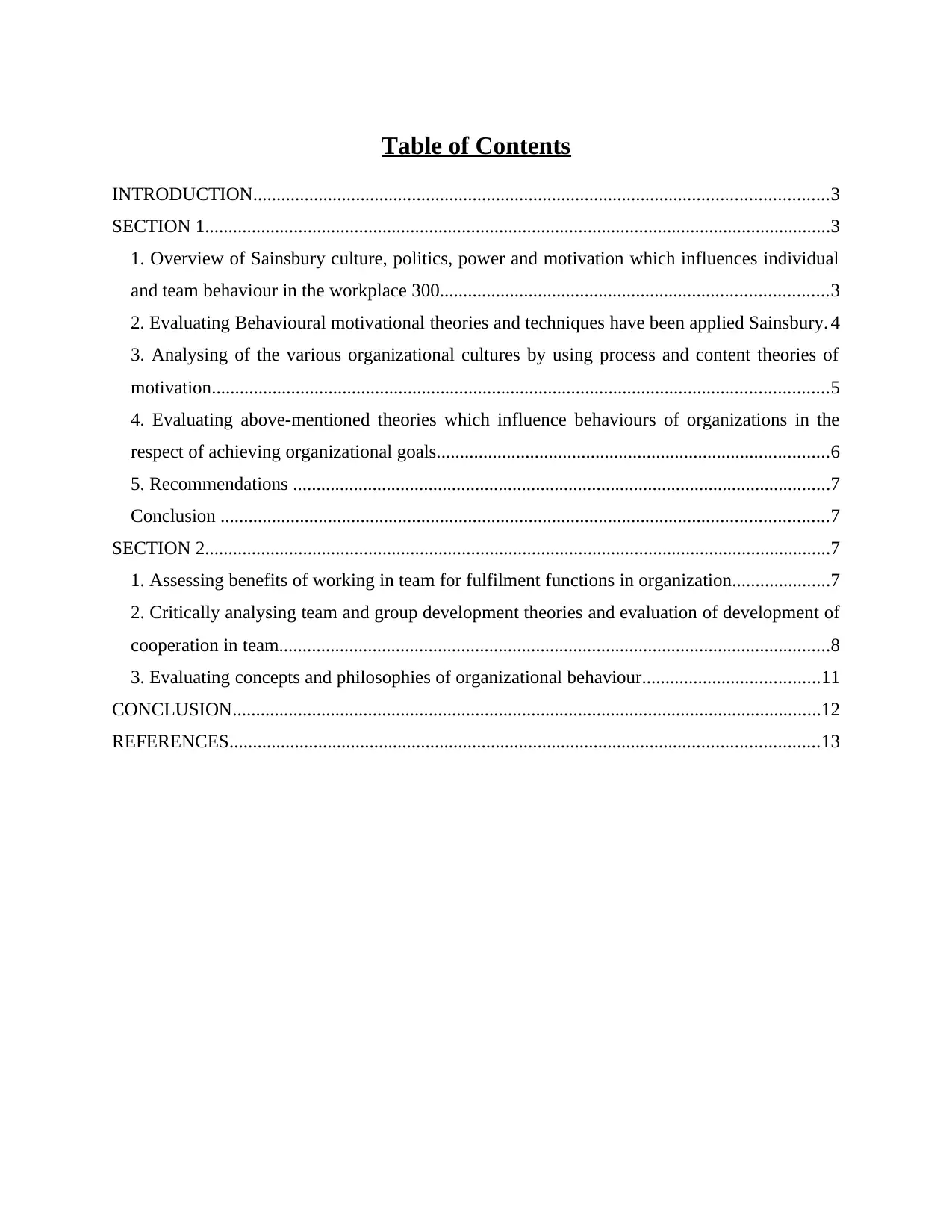
Table of Contents
INTRODUCTION...........................................................................................................................3
SECTION 1......................................................................................................................................3
1. Overview of Sainsbury culture, politics, power and motivation which influences individual
and team behaviour in the workplace 300...................................................................................3
2. Evaluating Behavioural motivational theories and techniques have been applied Sainsbury. 4
3. Analysing of the various organizational cultures by using process and content theories of
motivation....................................................................................................................................5
4. Evaluating above-mentioned theories which influence behaviours of organizations in the
respect of achieving organizational goals....................................................................................6
5. Recommendations ...................................................................................................................7
Conclusion ..................................................................................................................................7
SECTION 2......................................................................................................................................7
1. Assessing benefits of working in team for fulfilment functions in organization.....................7
2. Critically analysing team and group development theories and evaluation of development of
cooperation in team......................................................................................................................8
3. Evaluating concepts and philosophies of organizational behaviour......................................11
CONCLUSION..............................................................................................................................12
REFERENCES..............................................................................................................................13
INTRODUCTION...........................................................................................................................3
SECTION 1......................................................................................................................................3
1. Overview of Sainsbury culture, politics, power and motivation which influences individual
and team behaviour in the workplace 300...................................................................................3
2. Evaluating Behavioural motivational theories and techniques have been applied Sainsbury. 4
3. Analysing of the various organizational cultures by using process and content theories of
motivation....................................................................................................................................5
4. Evaluating above-mentioned theories which influence behaviours of organizations in the
respect of achieving organizational goals....................................................................................6
5. Recommendations ...................................................................................................................7
Conclusion ..................................................................................................................................7
SECTION 2......................................................................................................................................7
1. Assessing benefits of working in team for fulfilment functions in organization.....................7
2. Critically analysing team and group development theories and evaluation of development of
cooperation in team......................................................................................................................8
3. Evaluating concepts and philosophies of organizational behaviour......................................11
CONCLUSION..............................................................................................................................12
REFERENCES..............................................................................................................................13
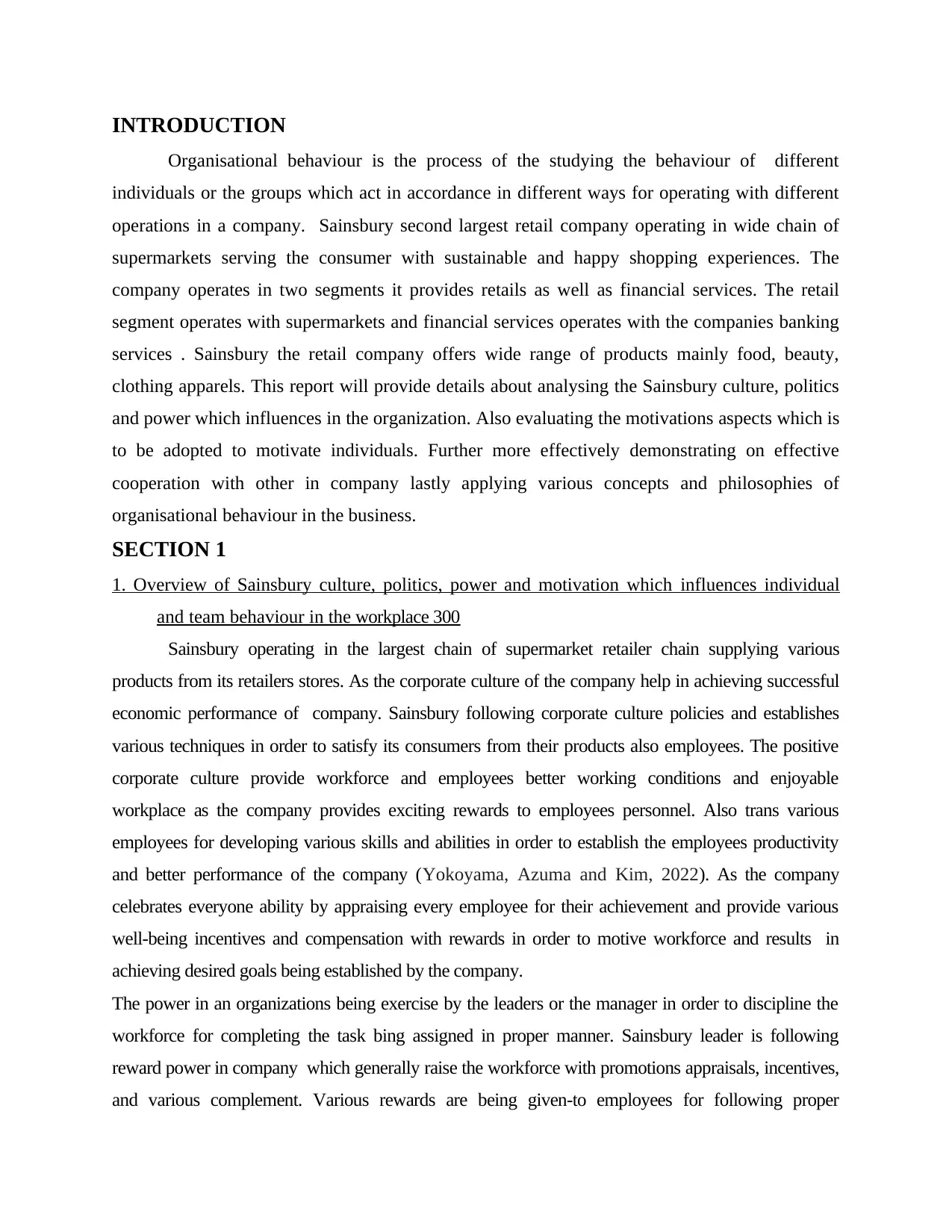
INTRODUCTION
Organisational behaviour is the process of the studying the behaviour of different
individuals or the groups which act in accordance in different ways for operating with different
operations in a company. Sainsbury second largest retail company operating in wide chain of
supermarkets serving the consumer with sustainable and happy shopping experiences. The
company operates in two segments it provides retails as well as financial services. The retail
segment operates with supermarkets and financial services operates with the companies banking
services . Sainsbury the retail company offers wide range of products mainly food, beauty,
clothing apparels. This report will provide details about analysing the Sainsbury culture, politics
and power which influences in the organization. Also evaluating the motivations aspects which is
to be adopted to motivate individuals. Further more effectively demonstrating on effective
cooperation with other in company lastly applying various concepts and philosophies of
organisational behaviour in the business.
SECTION 1
1. Overview of Sainsbury culture, politics, power and motivation which influences individual
and team behaviour in the workplace 300
Sainsbury operating in the largest chain of supermarket retailer chain supplying various
products from its retailers stores. As the corporate culture of the company help in achieving successful
economic performance of company. Sainsbury following corporate culture policies and establishes
various techniques in order to satisfy its consumers from their products also employees. The positive
corporate culture provide workforce and employees better working conditions and enjoyable
workplace as the company provides exciting rewards to employees personnel. Also trans various
employees for developing various skills and abilities in order to establish the employees productivity
and better performance of the company (Yokoyama, Azuma and Kim, 2022). As the company
celebrates everyone ability by appraising every employee for their achievement and provide various
well-being incentives and compensation with rewards in order to motive workforce and results in
achieving desired goals being established by the company.
The power in an organizations being exercise by the leaders or the manager in order to discipline the
workforce for completing the task bing assigned in proper manner. Sainsbury leader is following
reward power in company which generally raise the workforce with promotions appraisals, incentives,
and various complement. Various rewards are being given-to employees for following proper
Organisational behaviour is the process of the studying the behaviour of different
individuals or the groups which act in accordance in different ways for operating with different
operations in a company. Sainsbury second largest retail company operating in wide chain of
supermarkets serving the consumer with sustainable and happy shopping experiences. The
company operates in two segments it provides retails as well as financial services. The retail
segment operates with supermarkets and financial services operates with the companies banking
services . Sainsbury the retail company offers wide range of products mainly food, beauty,
clothing apparels. This report will provide details about analysing the Sainsbury culture, politics
and power which influences in the organization. Also evaluating the motivations aspects which is
to be adopted to motivate individuals. Further more effectively demonstrating on effective
cooperation with other in company lastly applying various concepts and philosophies of
organisational behaviour in the business.
SECTION 1
1. Overview of Sainsbury culture, politics, power and motivation which influences individual
and team behaviour in the workplace 300
Sainsbury operating in the largest chain of supermarket retailer chain supplying various
products from its retailers stores. As the corporate culture of the company help in achieving successful
economic performance of company. Sainsbury following corporate culture policies and establishes
various techniques in order to satisfy its consumers from their products also employees. The positive
corporate culture provide workforce and employees better working conditions and enjoyable
workplace as the company provides exciting rewards to employees personnel. Also trans various
employees for developing various skills and abilities in order to establish the employees productivity
and better performance of the company (Yokoyama, Azuma and Kim, 2022). As the company
celebrates everyone ability by appraising every employee for their achievement and provide various
well-being incentives and compensation with rewards in order to motive workforce and results in
achieving desired goals being established by the company.
The power in an organizations being exercise by the leaders or the manager in order to discipline the
workforce for completing the task bing assigned in proper manner. Sainsbury leader is following
reward power in company which generally raise the workforce with promotions appraisals, incentives,
and various complement. Various rewards are being given-to employees for following proper
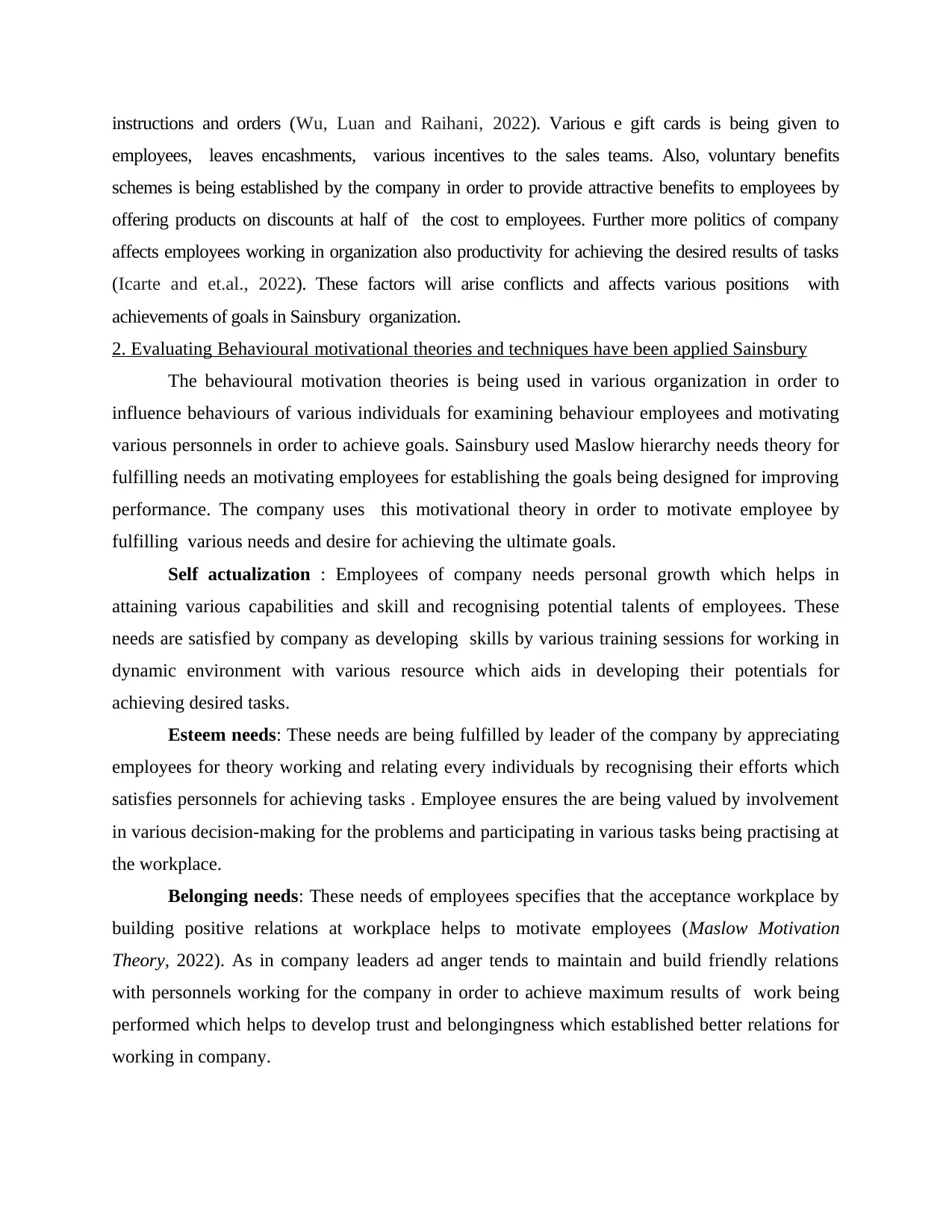
instructions and orders (Wu, Luan and Raihani, 2022). Various e gift cards is being given to
employees, leaves encashments, various incentives to the sales teams. Also, voluntary benefits
schemes is being established by the company in order to provide attractive benefits to employees by
offering products on discounts at half of the cost to employees. Further more politics of company
affects employees working in organization also productivity for achieving the desired results of tasks
(Icarte and et.al., 2022). These factors will arise conflicts and affects various positions with
achievements of goals in Sainsbury organization.
2. Evaluating Behavioural motivational theories and techniques have been applied Sainsbury
The behavioural motivation theories is being used in various organization in order to
influence behaviours of various individuals for examining behaviour employees and motivating
various personnels in order to achieve goals. Sainsbury used Maslow hierarchy needs theory for
fulfilling needs an motivating employees for establishing the goals being designed for improving
performance. The company uses this motivational theory in order to motivate employee by
fulfilling various needs and desire for achieving the ultimate goals.
Self actualization : Employees of company needs personal growth which helps in
attaining various capabilities and skill and recognising potential talents of employees. These
needs are satisfied by company as developing skills by various training sessions for working in
dynamic environment with various resource which aids in developing their potentials for
achieving desired tasks.
Esteem needs: These needs are being fulfilled by leader of the company by appreciating
employees for theory working and relating every individuals by recognising their efforts which
satisfies personnels for achieving tasks . Employee ensures the are being valued by involvement
in various decision-making for the problems and participating in various tasks being practising at
the workplace.
Belonging needs: These needs of employees specifies that the acceptance workplace by
building positive relations at workplace helps to motivate employees (Maslow Motivation
Theory, 2022). As in company leaders ad anger tends to maintain and build friendly relations
with personnels working for the company in order to achieve maximum results of work being
performed which helps to develop trust and belongingness which established better relations for
working in company.
employees, leaves encashments, various incentives to the sales teams. Also, voluntary benefits
schemes is being established by the company in order to provide attractive benefits to employees by
offering products on discounts at half of the cost to employees. Further more politics of company
affects employees working in organization also productivity for achieving the desired results of tasks
(Icarte and et.al., 2022). These factors will arise conflicts and affects various positions with
achievements of goals in Sainsbury organization.
2. Evaluating Behavioural motivational theories and techniques have been applied Sainsbury
The behavioural motivation theories is being used in various organization in order to
influence behaviours of various individuals for examining behaviour employees and motivating
various personnels in order to achieve goals. Sainsbury used Maslow hierarchy needs theory for
fulfilling needs an motivating employees for establishing the goals being designed for improving
performance. The company uses this motivational theory in order to motivate employee by
fulfilling various needs and desire for achieving the ultimate goals.
Self actualization : Employees of company needs personal growth which helps in
attaining various capabilities and skill and recognising potential talents of employees. These
needs are satisfied by company as developing skills by various training sessions for working in
dynamic environment with various resource which aids in developing their potentials for
achieving desired tasks.
Esteem needs: These needs are being fulfilled by leader of the company by appreciating
employees for theory working and relating every individuals by recognising their efforts which
satisfies personnels for achieving tasks . Employee ensures the are being valued by involvement
in various decision-making for the problems and participating in various tasks being practising at
the workplace.
Belonging needs: These needs of employees specifies that the acceptance workplace by
building positive relations at workplace helps to motivate employees (Maslow Motivation
Theory, 2022). As in company leaders ad anger tends to maintain and build friendly relations
with personnels working for the company in order to achieve maximum results of work being
performed which helps to develop trust and belongingness which established better relations for
working in company.
Secure Best Marks with AI Grader
Need help grading? Try our AI Grader for instant feedback on your assignments.
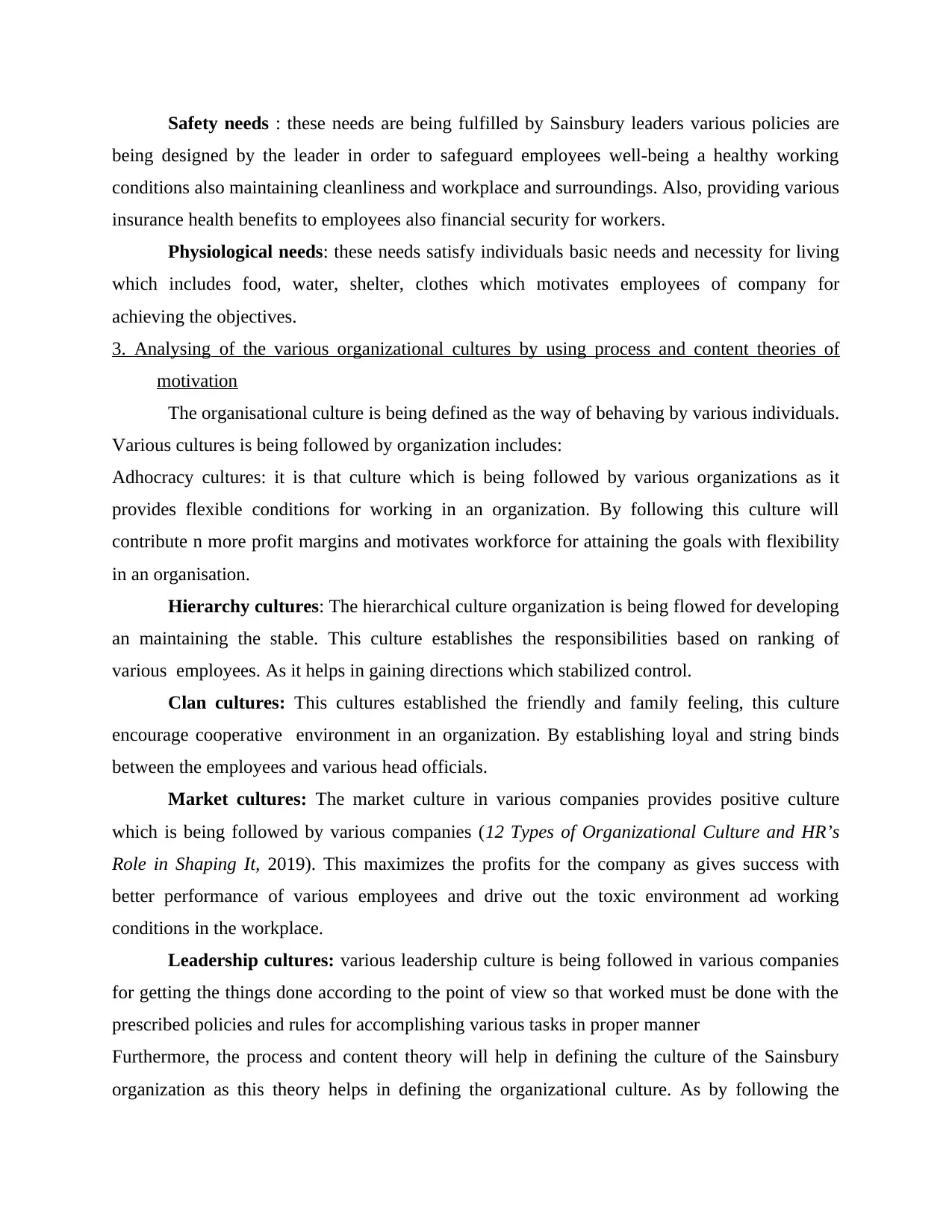
Safety needs : these needs are being fulfilled by Sainsbury leaders various policies are
being designed by the leader in order to safeguard employees well-being a healthy working
conditions also maintaining cleanliness and workplace and surroundings. Also, providing various
insurance health benefits to employees also financial security for workers.
Physiological needs: these needs satisfy individuals basic needs and necessity for living
which includes food, water, shelter, clothes which motivates employees of company for
achieving the objectives.
3. Analysing of the various organizational cultures by using process and content theories of
motivation
The organisational culture is being defined as the way of behaving by various individuals.
Various cultures is being followed by organization includes:
Adhocracy cultures: it is that culture which is being followed by various organizations as it
provides flexible conditions for working in an organization. By following this culture will
contribute n more profit margins and motivates workforce for attaining the goals with flexibility
in an organisation.
Hierarchy cultures: The hierarchical culture organization is being flowed for developing
an maintaining the stable. This culture establishes the responsibilities based on ranking of
various employees. As it helps in gaining directions which stabilized control.
Clan cultures: This cultures established the friendly and family feeling, this culture
encourage cooperative environment in an organization. By establishing loyal and string binds
between the employees and various head officials.
Market cultures: The market culture in various companies provides positive culture
which is being followed by various companies (12 Types of Organizational Culture and HR’s
Role in Shaping It, 2019). This maximizes the profits for the company as gives success with
better performance of various employees and drive out the toxic environment ad working
conditions in the workplace.
Leadership cultures: various leadership culture is being followed in various companies
for getting the things done according to the point of view so that worked must be done with the
prescribed policies and rules for accomplishing various tasks in proper manner
Furthermore, the process and content theory will help in defining the culture of the Sainsbury
organization as this theory helps in defining the organizational culture. As by following the
being designed by the leader in order to safeguard employees well-being a healthy working
conditions also maintaining cleanliness and workplace and surroundings. Also, providing various
insurance health benefits to employees also financial security for workers.
Physiological needs: these needs satisfy individuals basic needs and necessity for living
which includes food, water, shelter, clothes which motivates employees of company for
achieving the objectives.
3. Analysing of the various organizational cultures by using process and content theories of
motivation
The organisational culture is being defined as the way of behaving by various individuals.
Various cultures is being followed by organization includes:
Adhocracy cultures: it is that culture which is being followed by various organizations as it
provides flexible conditions for working in an organization. By following this culture will
contribute n more profit margins and motivates workforce for attaining the goals with flexibility
in an organisation.
Hierarchy cultures: The hierarchical culture organization is being flowed for developing
an maintaining the stable. This culture establishes the responsibilities based on ranking of
various employees. As it helps in gaining directions which stabilized control.
Clan cultures: This cultures established the friendly and family feeling, this culture
encourage cooperative environment in an organization. By establishing loyal and string binds
between the employees and various head officials.
Market cultures: The market culture in various companies provides positive culture
which is being followed by various companies (12 Types of Organizational Culture and HR’s
Role in Shaping It, 2019). This maximizes the profits for the company as gives success with
better performance of various employees and drive out the toxic environment ad working
conditions in the workplace.
Leadership cultures: various leadership culture is being followed in various companies
for getting the things done according to the point of view so that worked must be done with the
prescribed policies and rules for accomplishing various tasks in proper manner
Furthermore, the process and content theory will help in defining the culture of the Sainsbury
organization as this theory helps in defining the organizational culture. As by following the
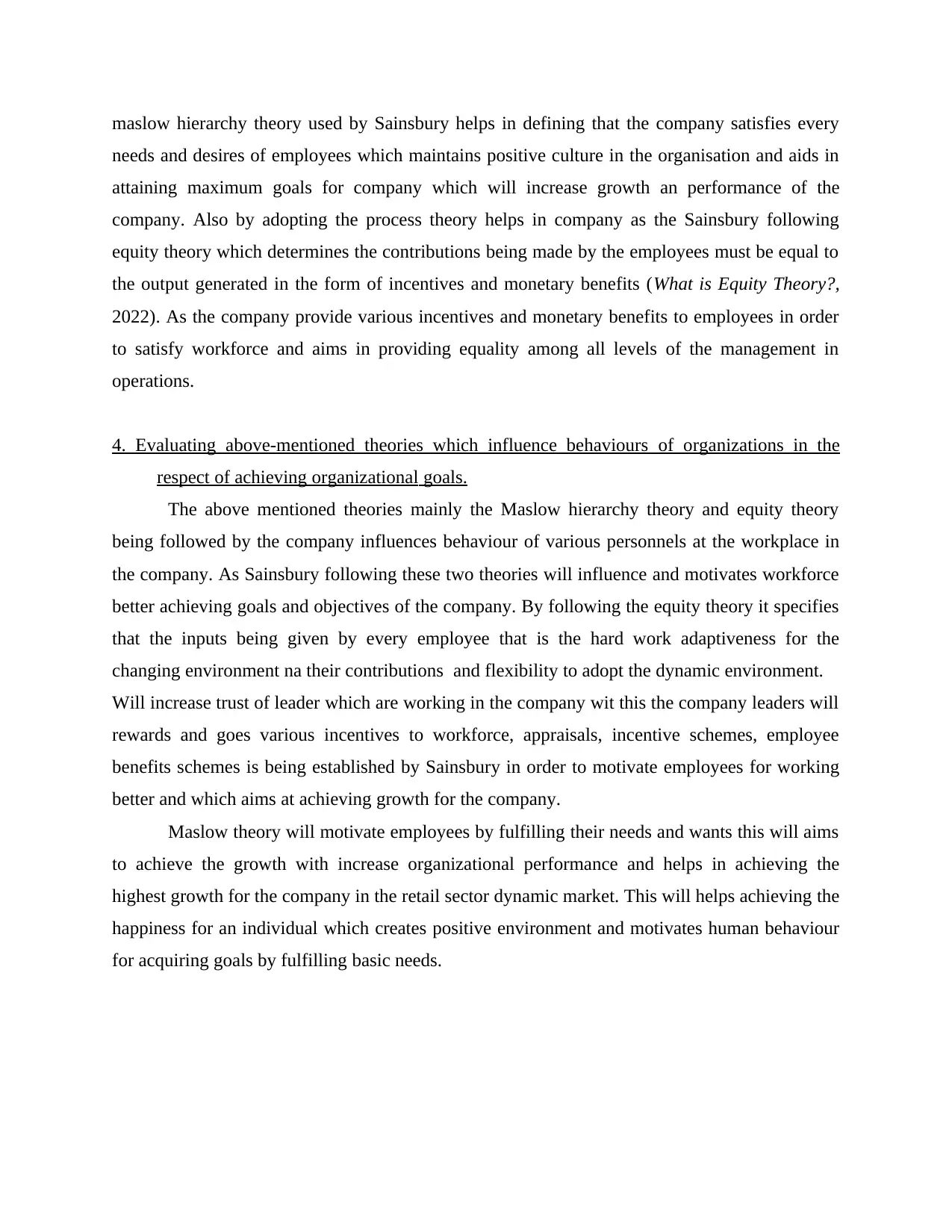
maslow hierarchy theory used by Sainsbury helps in defining that the company satisfies every
needs and desires of employees which maintains positive culture in the organisation and aids in
attaining maximum goals for company which will increase growth an performance of the
company. Also by adopting the process theory helps in company as the Sainsbury following
equity theory which determines the contributions being made by the employees must be equal to
the output generated in the form of incentives and monetary benefits (What is Equity Theory?,
2022). As the company provide various incentives and monetary benefits to employees in order
to satisfy workforce and aims in providing equality among all levels of the management in
operations.
4. Evaluating above-mentioned theories which influence behaviours of organizations in the
respect of achieving organizational goals.
The above mentioned theories mainly the Maslow hierarchy theory and equity theory
being followed by the company influences behaviour of various personnels at the workplace in
the company. As Sainsbury following these two theories will influence and motivates workforce
better achieving goals and objectives of the company. By following the equity theory it specifies
that the inputs being given by every employee that is the hard work adaptiveness for the
changing environment na their contributions and flexibility to adopt the dynamic environment.
Will increase trust of leader which are working in the company wit this the company leaders will
rewards and goes various incentives to workforce, appraisals, incentive schemes, employee
benefits schemes is being established by Sainsbury in order to motivate employees for working
better and which aims at achieving growth for the company.
Maslow theory will motivate employees by fulfilling their needs and wants this will aims
to achieve the growth with increase organizational performance and helps in achieving the
highest growth for the company in the retail sector dynamic market. This will helps achieving the
happiness for an individual which creates positive environment and motivates human behaviour
for acquiring goals by fulfilling basic needs.
needs and desires of employees which maintains positive culture in the organisation and aids in
attaining maximum goals for company which will increase growth an performance of the
company. Also by adopting the process theory helps in company as the Sainsbury following
equity theory which determines the contributions being made by the employees must be equal to
the output generated in the form of incentives and monetary benefits (What is Equity Theory?,
2022). As the company provide various incentives and monetary benefits to employees in order
to satisfy workforce and aims in providing equality among all levels of the management in
operations.
4. Evaluating above-mentioned theories which influence behaviours of organizations in the
respect of achieving organizational goals.
The above mentioned theories mainly the Maslow hierarchy theory and equity theory
being followed by the company influences behaviour of various personnels at the workplace in
the company. As Sainsbury following these two theories will influence and motivates workforce
better achieving goals and objectives of the company. By following the equity theory it specifies
that the inputs being given by every employee that is the hard work adaptiveness for the
changing environment na their contributions and flexibility to adopt the dynamic environment.
Will increase trust of leader which are working in the company wit this the company leaders will
rewards and goes various incentives to workforce, appraisals, incentive schemes, employee
benefits schemes is being established by Sainsbury in order to motivate employees for working
better and which aims at achieving growth for the company.
Maslow theory will motivate employees by fulfilling their needs and wants this will aims
to achieve the growth with increase organizational performance and helps in achieving the
highest growth for the company in the retail sector dynamic market. This will helps achieving the
happiness for an individual which creates positive environment and motivates human behaviour
for acquiring goals by fulfilling basic needs.
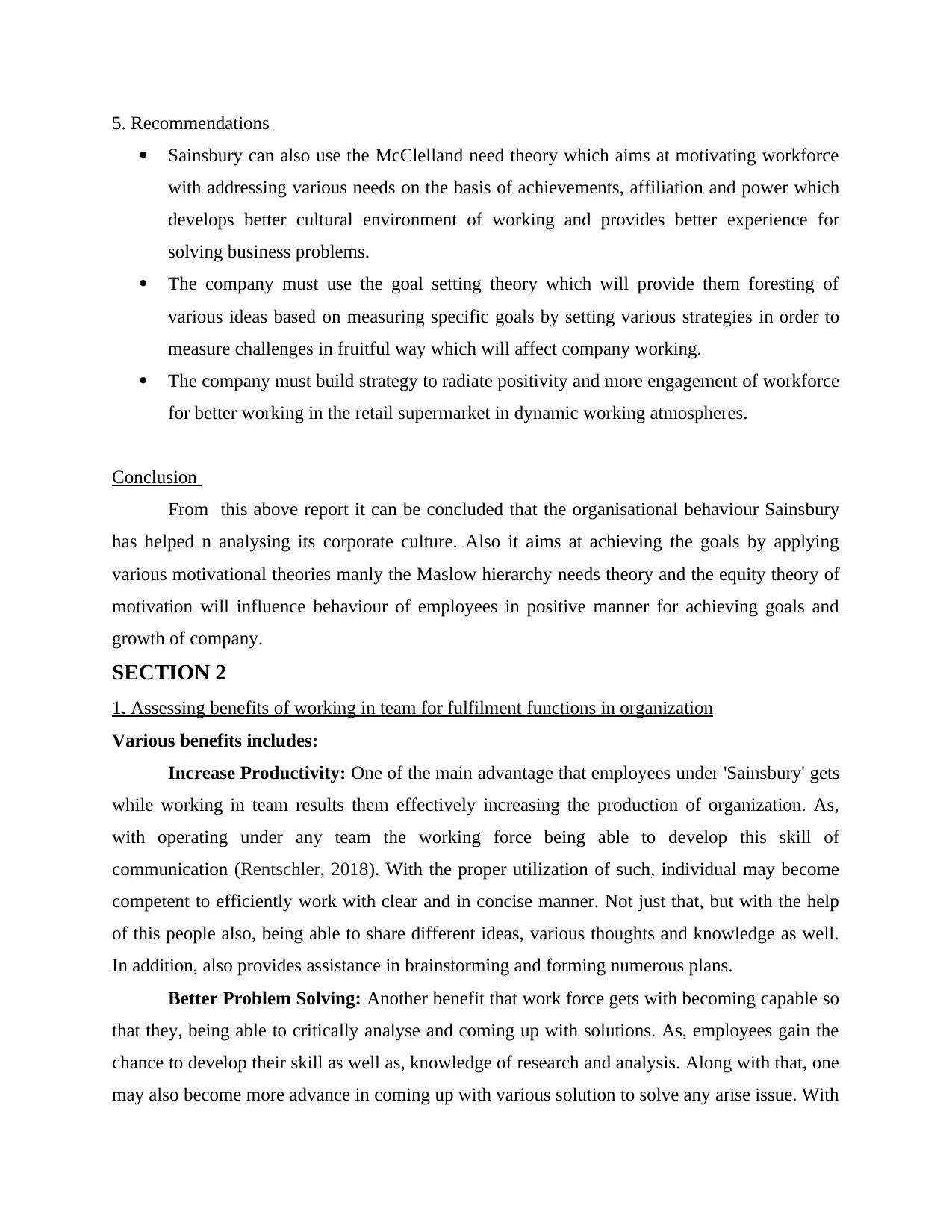
5. Recommendations
Sainsbury can also use the McClelland need theory which aims at motivating workforce
with addressing various needs on the basis of achievements, affiliation and power which
develops better cultural environment of working and provides better experience for
solving business problems.
The company must use the goal setting theory which will provide them foresting of
various ideas based on measuring specific goals by setting various strategies in order to
measure challenges in fruitful way which will affect company working.
The company must build strategy to radiate positivity and more engagement of workforce
for better working in the retail supermarket in dynamic working atmospheres.
Conclusion
From this above report it can be concluded that the organisational behaviour Sainsbury
has helped n analysing its corporate culture. Also it aims at achieving the goals by applying
various motivational theories manly the Maslow hierarchy needs theory and the equity theory of
motivation will influence behaviour of employees in positive manner for achieving goals and
growth of company.
SECTION 2
1. Assessing benefits of working in team for fulfilment functions in organization
Various benefits includes:
Increase Productivity: One of the main advantage that employees under 'Sainsbury' gets
while working in team results them effectively increasing the production of organization. As,
with operating under any team the working force being able to develop this skill of
communication (Rentschler, 2018). With the proper utilization of such, individual may become
competent to efficiently work with clear and in concise manner. Not just that, but with the help
of this people also, being able to share different ideas, various thoughts and knowledge as well.
In addition, also provides assistance in brainstorming and forming numerous plans.
Better Problem Solving: Another benefit that work force gets with becoming capable so
that they, being able to critically analyse and coming up with solutions. As, employees gain the
chance to develop their skill as well as, knowledge of research and analysis. Along with that, one
may also become more advance in coming up with various solution to solve any arise issue. With
Sainsbury can also use the McClelland need theory which aims at motivating workforce
with addressing various needs on the basis of achievements, affiliation and power which
develops better cultural environment of working and provides better experience for
solving business problems.
The company must use the goal setting theory which will provide them foresting of
various ideas based on measuring specific goals by setting various strategies in order to
measure challenges in fruitful way which will affect company working.
The company must build strategy to radiate positivity and more engagement of workforce
for better working in the retail supermarket in dynamic working atmospheres.
Conclusion
From this above report it can be concluded that the organisational behaviour Sainsbury
has helped n analysing its corporate culture. Also it aims at achieving the goals by applying
various motivational theories manly the Maslow hierarchy needs theory and the equity theory of
motivation will influence behaviour of employees in positive manner for achieving goals and
growth of company.
SECTION 2
1. Assessing benefits of working in team for fulfilment functions in organization
Various benefits includes:
Increase Productivity: One of the main advantage that employees under 'Sainsbury' gets
while working in team results them effectively increasing the production of organization. As,
with operating under any team the working force being able to develop this skill of
communication (Rentschler, 2018). With the proper utilization of such, individual may become
competent to efficiently work with clear and in concise manner. Not just that, but with the help
of this people also, being able to share different ideas, various thoughts and knowledge as well.
In addition, also provides assistance in brainstorming and forming numerous plans.
Better Problem Solving: Another benefit that work force gets with becoming capable so
that they, being able to critically analyse and coming up with solutions. As, employees gain the
chance to develop their skill as well as, knowledge of research and analysis. Along with that, one
may also become more advance in coming up with various solution to solve any arise issue. With
Paraphrase This Document
Need a fresh take? Get an instant paraphrase of this document with our AI Paraphraser
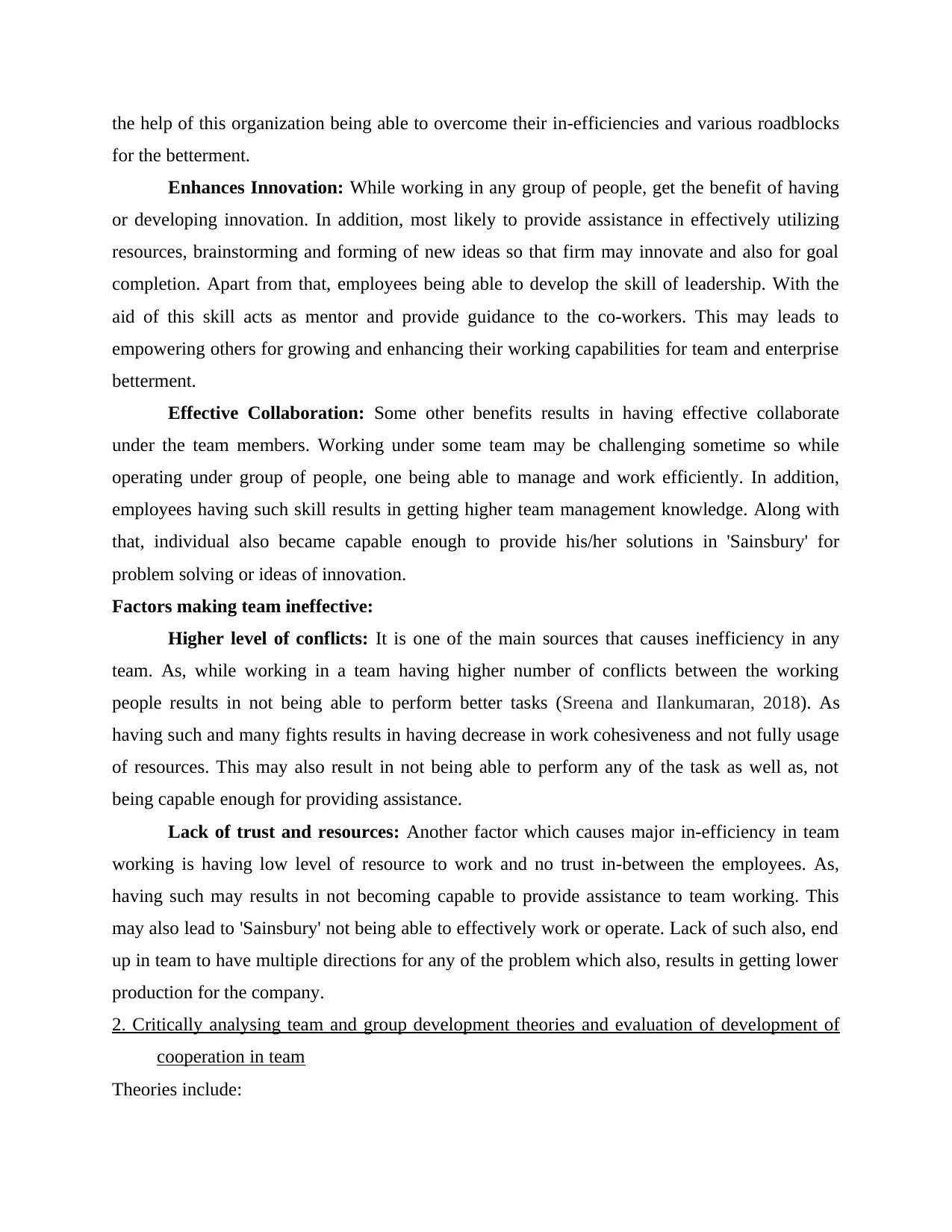
the help of this organization being able to overcome their in-efficiencies and various roadblocks
for the betterment.
Enhances Innovation: While working in any group of people, get the benefit of having
or developing innovation. In addition, most likely to provide assistance in effectively utilizing
resources, brainstorming and forming of new ideas so that firm may innovate and also for goal
completion. Apart from that, employees being able to develop the skill of leadership. With the
aid of this skill acts as mentor and provide guidance to the co-workers. This may leads to
empowering others for growing and enhancing their working capabilities for team and enterprise
betterment.
Effective Collaboration: Some other benefits results in having effective collaborate
under the team members. Working under some team may be challenging sometime so while
operating under group of people, one being able to manage and work efficiently. In addition,
employees having such skill results in getting higher team management knowledge. Along with
that, individual also became capable enough to provide his/her solutions in 'Sainsbury' for
problem solving or ideas of innovation.
Factors making team ineffective:
Higher level of conflicts: It is one of the main sources that causes inefficiency in any
team. As, while working in a team having higher number of conflicts between the working
people results in not being able to perform better tasks (Sreena and Ilankumaran, 2018). As
having such and many fights results in having decrease in work cohesiveness and not fully usage
of resources. This may also result in not being able to perform any of the task as well as, not
being capable enough for providing assistance.
Lack of trust and resources: Another factor which causes major in-efficiency in team
working is having low level of resource to work and no trust in-between the employees. As,
having such may results in not becoming capable to provide assistance to team working. This
may also lead to 'Sainsbury' not being able to effectively work or operate. Lack of such also, end
up in team to have multiple directions for any of the problem which also, results in getting lower
production for the company.
2. Critically analysing team and group development theories and evaluation of development of
cooperation in team
Theories include:
for the betterment.
Enhances Innovation: While working in any group of people, get the benefit of having
or developing innovation. In addition, most likely to provide assistance in effectively utilizing
resources, brainstorming and forming of new ideas so that firm may innovate and also for goal
completion. Apart from that, employees being able to develop the skill of leadership. With the
aid of this skill acts as mentor and provide guidance to the co-workers. This may leads to
empowering others for growing and enhancing their working capabilities for team and enterprise
betterment.
Effective Collaboration: Some other benefits results in having effective collaborate
under the team members. Working under some team may be challenging sometime so while
operating under group of people, one being able to manage and work efficiently. In addition,
employees having such skill results in getting higher team management knowledge. Along with
that, individual also became capable enough to provide his/her solutions in 'Sainsbury' for
problem solving or ideas of innovation.
Factors making team ineffective:
Higher level of conflicts: It is one of the main sources that causes inefficiency in any
team. As, while working in a team having higher number of conflicts between the working
people results in not being able to perform better tasks (Sreena and Ilankumaran, 2018). As
having such and many fights results in having decrease in work cohesiveness and not fully usage
of resources. This may also result in not being able to perform any of the task as well as, not
being capable enough for providing assistance.
Lack of trust and resources: Another factor which causes major in-efficiency in team
working is having low level of resource to work and no trust in-between the employees. As,
having such may results in not becoming capable to provide assistance to team working. This
may also lead to 'Sainsbury' not being able to effectively work or operate. Lack of such also, end
up in team to have multiple directions for any of the problem which also, results in getting lower
production for the company.
2. Critically analysing team and group development theories and evaluation of development of
cooperation in team
Theories include:
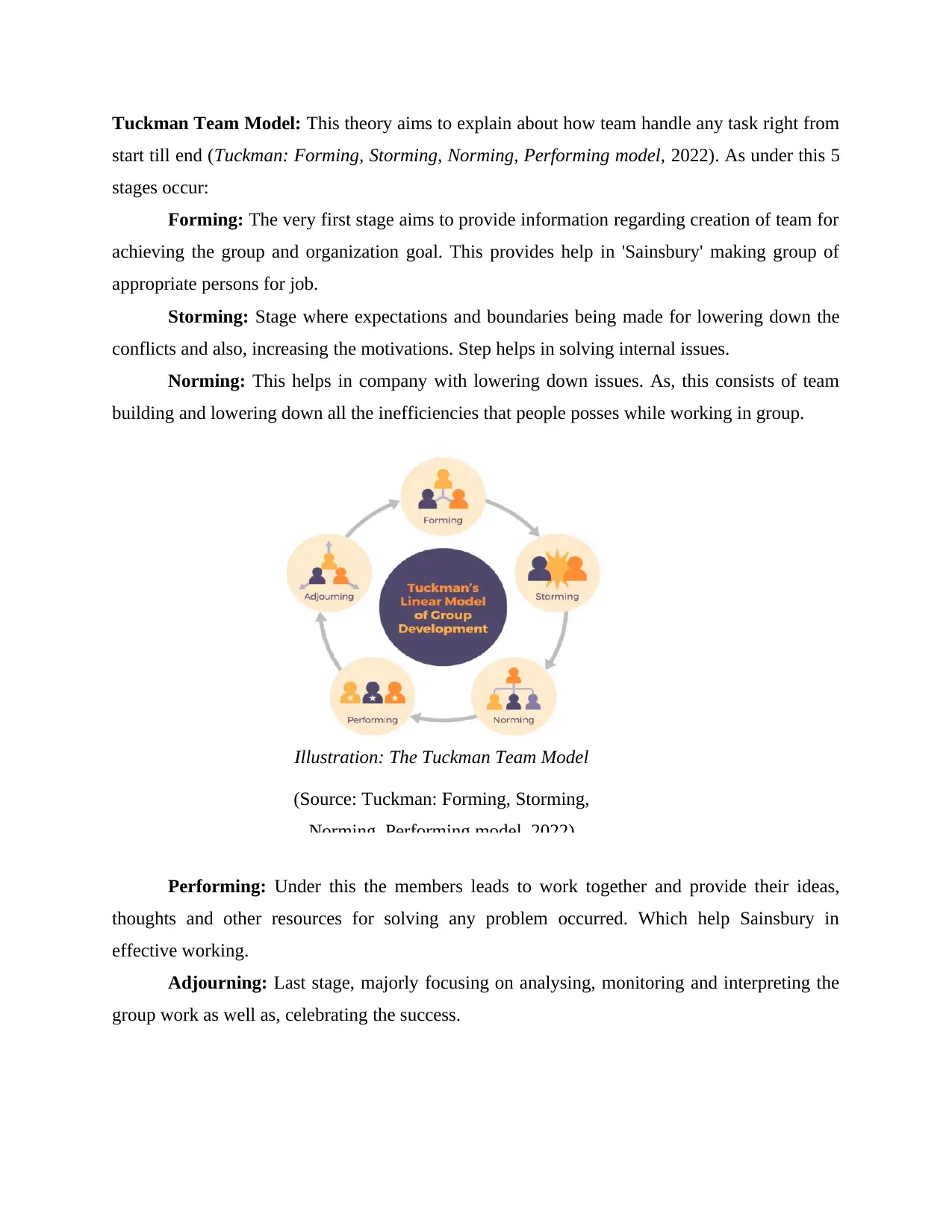
Tuckman Team Model: This theory aims to explain about how team handle any task right from
start till end (Tuckman: Forming, Storming, Norming, Performing model, 2022). As under this 5
stages occur:
Forming: The very first stage aims to provide information regarding creation of team for
achieving the group and organization goal. This provides help in 'Sainsbury' making group of
appropriate persons for job.
Storming: Stage where expectations and boundaries being made for lowering down the
conflicts and also, increasing the motivations. Step helps in solving internal issues.
Norming: This helps in company with lowering down issues. As, this consists of team
building and lowering down all the inefficiencies that people posses while working in group.
Performing: Under this the members leads to work together and provide their ideas,
thoughts and other resources for solving any problem occurred. Which help Sainsbury in
effective working.
Adjourning: Last stage, majorly focusing on analysing, monitoring and interpreting the
group work as well as, celebrating the success.
Illustration: The Tuckman Team Model
(Source: Tuckman: Forming, Storming,
Norming, Performing model, 2022)
start till end (Tuckman: Forming, Storming, Norming, Performing model, 2022). As under this 5
stages occur:
Forming: The very first stage aims to provide information regarding creation of team for
achieving the group and organization goal. This provides help in 'Sainsbury' making group of
appropriate persons for job.
Storming: Stage where expectations and boundaries being made for lowering down the
conflicts and also, increasing the motivations. Step helps in solving internal issues.
Norming: This helps in company with lowering down issues. As, this consists of team
building and lowering down all the inefficiencies that people posses while working in group.
Performing: Under this the members leads to work together and provide their ideas,
thoughts and other resources for solving any problem occurred. Which help Sainsbury in
effective working.
Adjourning: Last stage, majorly focusing on analysing, monitoring and interpreting the
group work as well as, celebrating the success.
Illustration: The Tuckman Team Model
(Source: Tuckman: Forming, Storming,
Norming, Performing model, 2022)
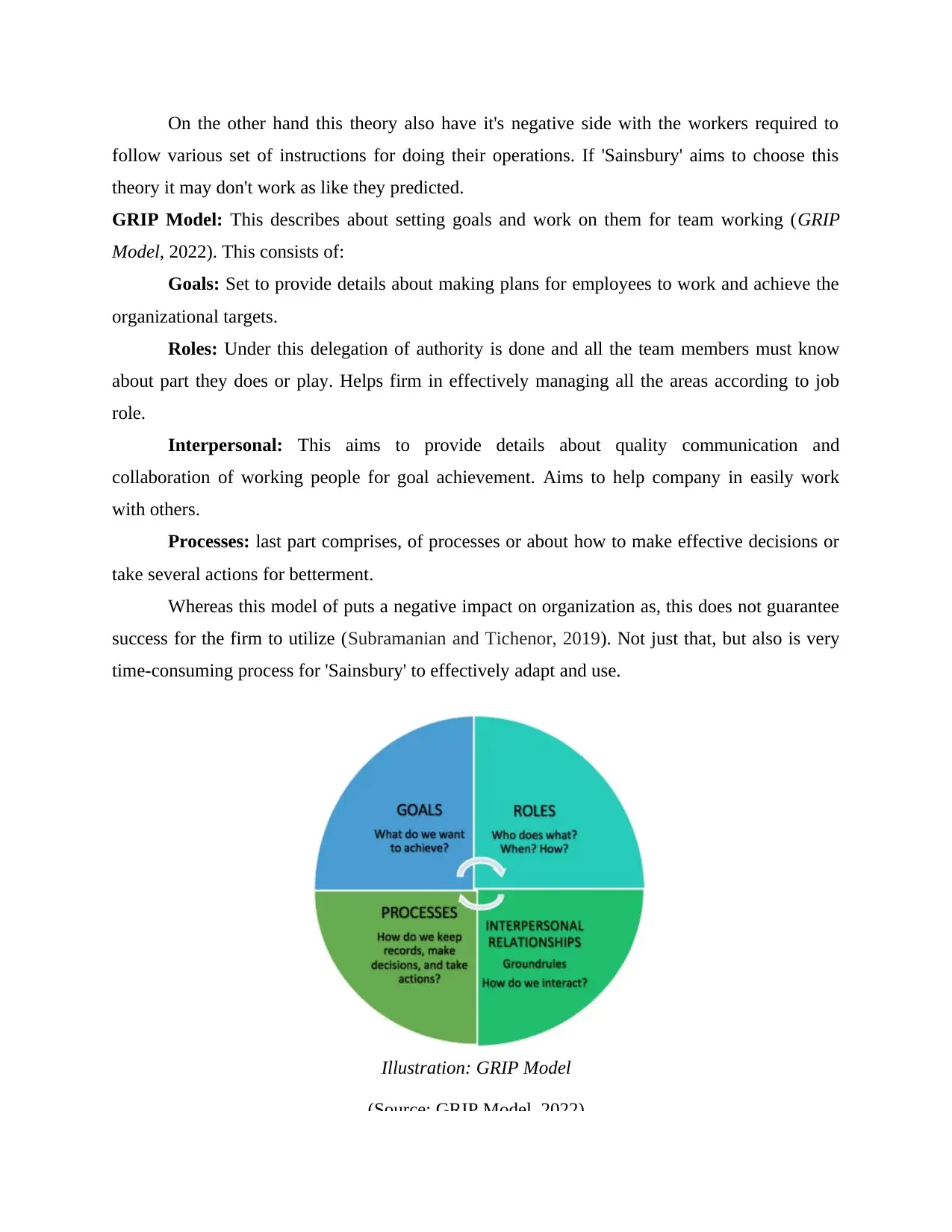
On the other hand this theory also have it's negative side with the workers required to
follow various set of instructions for doing their operations. If 'Sainsbury' aims to choose this
theory it may don't work as like they predicted.
GRIP Model: This describes about setting goals and work on them for team working (GRIP
Model, 2022). This consists of:
Goals: Set to provide details about making plans for employees to work and achieve the
organizational targets.
Roles: Under this delegation of authority is done and all the team members must know
about part they does or play. Helps firm in effectively managing all the areas according to job
role.
Interpersonal: This aims to provide details about quality communication and
collaboration of working people for goal achievement. Aims to help company in easily work
with others.
Processes: last part comprises, of processes or about how to make effective decisions or
take several actions for betterment.
Whereas this model of puts a negative impact on organization as, this does not guarantee
success for the firm to utilize (Subramanian and Tichenor, 2019). Not just that, but also is very
time-consuming process for 'Sainsbury' to effectively adapt and use.
Illustration: GRIP Model
(Source: GRIP Model, 2022)
follow various set of instructions for doing their operations. If 'Sainsbury' aims to choose this
theory it may don't work as like they predicted.
GRIP Model: This describes about setting goals and work on them for team working (GRIP
Model, 2022). This consists of:
Goals: Set to provide details about making plans for employees to work and achieve the
organizational targets.
Roles: Under this delegation of authority is done and all the team members must know
about part they does or play. Helps firm in effectively managing all the areas according to job
role.
Interpersonal: This aims to provide details about quality communication and
collaboration of working people for goal achievement. Aims to help company in easily work
with others.
Processes: last part comprises, of processes or about how to make effective decisions or
take several actions for betterment.
Whereas this model of puts a negative impact on organization as, this does not guarantee
success for the firm to utilize (Subramanian and Tichenor, 2019). Not just that, but also is very
time-consuming process for 'Sainsbury' to effectively adapt and use.
Illustration: GRIP Model
(Source: GRIP Model, 2022)
Secure Best Marks with AI Grader
Need help grading? Try our AI Grader for instant feedback on your assignments.
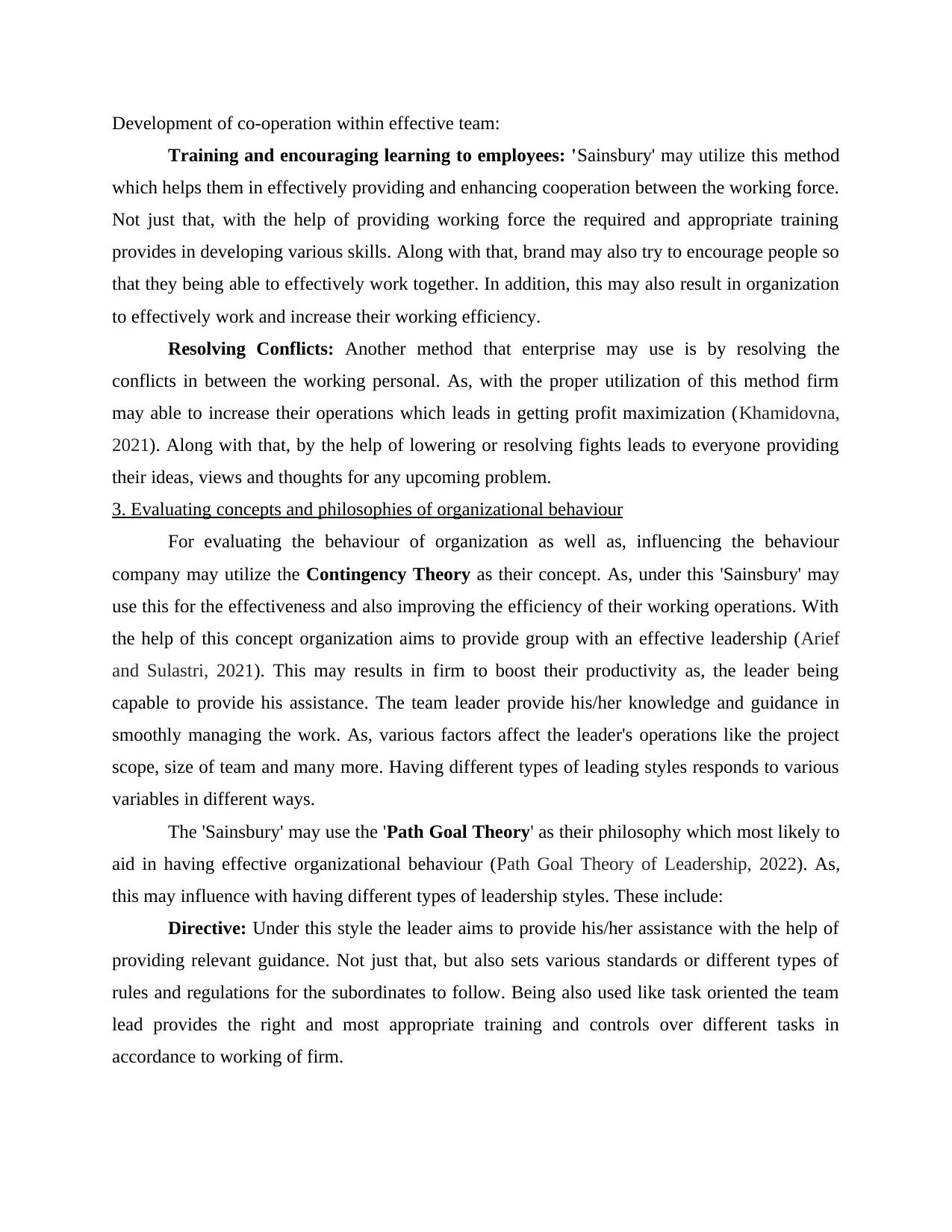
Development of co-operation within effective team:
Training and encouraging learning to employees: 'Sainsbury' may utilize this method
which helps them in effectively providing and enhancing cooperation between the working force.
Not just that, with the help of providing working force the required and appropriate training
provides in developing various skills. Along with that, brand may also try to encourage people so
that they being able to effectively work together. In addition, this may also result in organization
to effectively work and increase their working efficiency.
Resolving Conflicts: Another method that enterprise may use is by resolving the
conflicts in between the working personal. As, with the proper utilization of this method firm
may able to increase their operations which leads in getting profit maximization (Khamidovna,
2021). Along with that, by the help of lowering or resolving fights leads to everyone providing
their ideas, views and thoughts for any upcoming problem.
3. Evaluating concepts and philosophies of organizational behaviour
For evaluating the behaviour of organization as well as, influencing the behaviour
company may utilize the Contingency Theory as their concept. As, under this 'Sainsbury' may
use this for the effectiveness and also improving the efficiency of their working operations. With
the help of this concept organization aims to provide group with an effective leadership (Arief
and Sulastri, 2021). This may results in firm to boost their productivity as, the leader being
capable to provide his assistance. The team leader provide his/her knowledge and guidance in
smoothly managing the work. As, various factors affect the leader's operations like the project
scope, size of team and many more. Having different types of leading styles responds to various
variables in different ways.
The 'Sainsbury' may use the 'Path Goal Theory' as their philosophy which most likely to
aid in having effective organizational behaviour (Path Goal Theory of Leadership, 2022). As,
this may influence with having different types of leadership styles. These include:
Directive: Under this style the leader aims to provide his/her assistance with the help of
providing relevant guidance. Not just that, but also sets various standards or different types of
rules and regulations for the subordinates to follow. Being also used like task oriented the team
lead provides the right and most appropriate training and controls over different tasks in
accordance to working of firm.
Training and encouraging learning to employees: 'Sainsbury' may utilize this method
which helps them in effectively providing and enhancing cooperation between the working force.
Not just that, with the help of providing working force the required and appropriate training
provides in developing various skills. Along with that, brand may also try to encourage people so
that they being able to effectively work together. In addition, this may also result in organization
to effectively work and increase their working efficiency.
Resolving Conflicts: Another method that enterprise may use is by resolving the
conflicts in between the working personal. As, with the proper utilization of this method firm
may able to increase their operations which leads in getting profit maximization (Khamidovna,
2021). Along with that, by the help of lowering or resolving fights leads to everyone providing
their ideas, views and thoughts for any upcoming problem.
3. Evaluating concepts and philosophies of organizational behaviour
For evaluating the behaviour of organization as well as, influencing the behaviour
company may utilize the Contingency Theory as their concept. As, under this 'Sainsbury' may
use this for the effectiveness and also improving the efficiency of their working operations. With
the help of this concept organization aims to provide group with an effective leadership (Arief
and Sulastri, 2021). This may results in firm to boost their productivity as, the leader being
capable to provide his assistance. The team leader provide his/her knowledge and guidance in
smoothly managing the work. As, various factors affect the leader's operations like the project
scope, size of team and many more. Having different types of leading styles responds to various
variables in different ways.
The 'Sainsbury' may use the 'Path Goal Theory' as their philosophy which most likely to
aid in having effective organizational behaviour (Path Goal Theory of Leadership, 2022). As,
this may influence with having different types of leadership styles. These include:
Directive: Under this style the leader aims to provide his/her assistance with the help of
providing relevant guidance. Not just that, but also sets various standards or different types of
rules and regulations for the subordinates to follow. Being also used like task oriented the team
lead provides the right and most appropriate training and controls over different tasks in
accordance to working of firm.
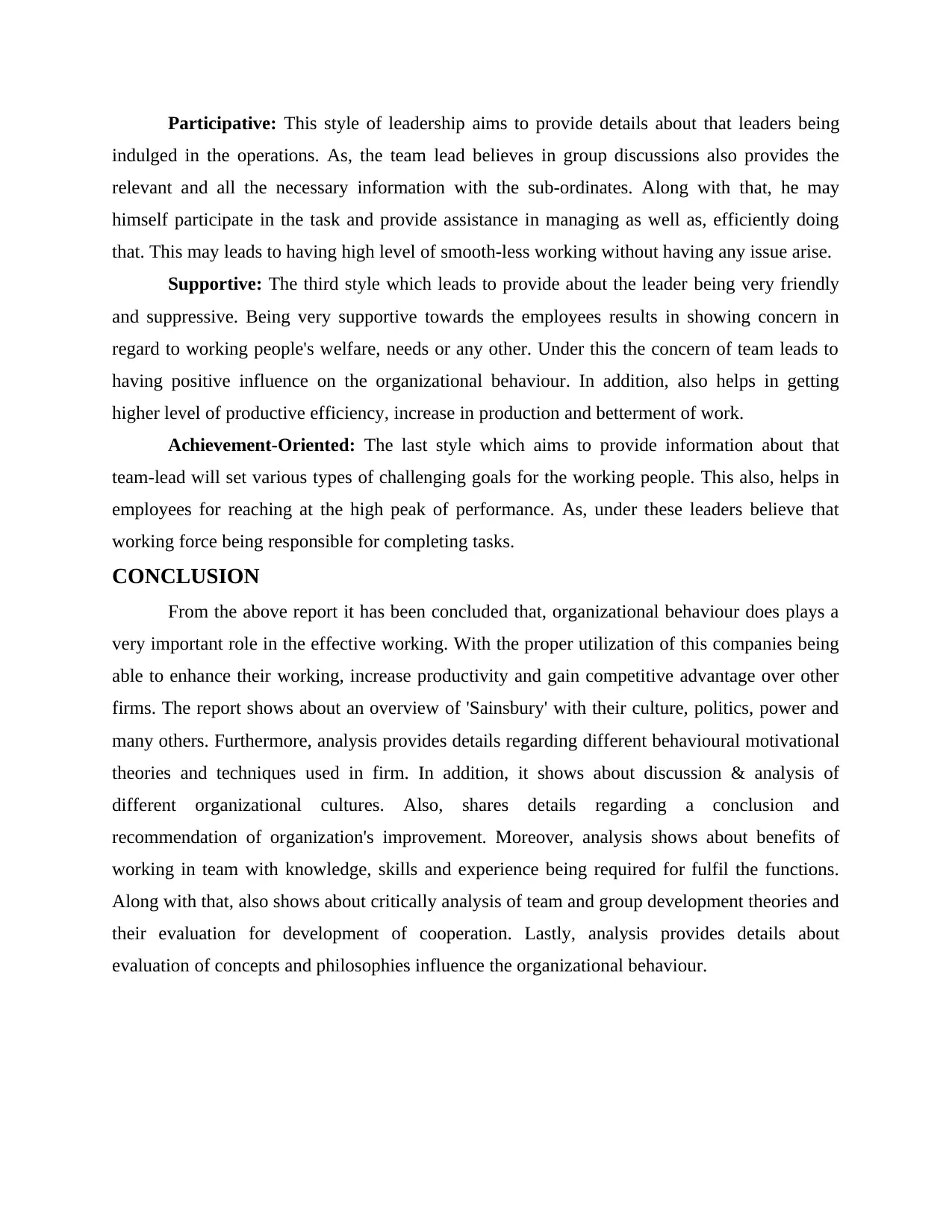
Participative: This style of leadership aims to provide details about that leaders being
indulged in the operations. As, the team lead believes in group discussions also provides the
relevant and all the necessary information with the sub-ordinates. Along with that, he may
himself participate in the task and provide assistance in managing as well as, efficiently doing
that. This may leads to having high level of smooth-less working without having any issue arise.
Supportive: The third style which leads to provide about the leader being very friendly
and suppressive. Being very supportive towards the employees results in showing concern in
regard to working people's welfare, needs or any other. Under this the concern of team leads to
having positive influence on the organizational behaviour. In addition, also helps in getting
higher level of productive efficiency, increase in production and betterment of work.
Achievement-Oriented: The last style which aims to provide information about that
team-lead will set various types of challenging goals for the working people. This also, helps in
employees for reaching at the high peak of performance. As, under these leaders believe that
working force being responsible for completing tasks.
CONCLUSION
From the above report it has been concluded that, organizational behaviour does plays a
very important role in the effective working. With the proper utilization of this companies being
able to enhance their working, increase productivity and gain competitive advantage over other
firms. The report shows about an overview of 'Sainsbury' with their culture, politics, power and
many others. Furthermore, analysis provides details regarding different behavioural motivational
theories and techniques used in firm. In addition, it shows about discussion & analysis of
different organizational cultures. Also, shares details regarding a conclusion and
recommendation of organization's improvement. Moreover, analysis shows about benefits of
working in team with knowledge, skills and experience being required for fulfil the functions.
Along with that, also shows about critically analysis of team and group development theories and
their evaluation for development of cooperation. Lastly, analysis provides details about
evaluation of concepts and philosophies influence the organizational behaviour.
indulged in the operations. As, the team lead believes in group discussions also provides the
relevant and all the necessary information with the sub-ordinates. Along with that, he may
himself participate in the task and provide assistance in managing as well as, efficiently doing
that. This may leads to having high level of smooth-less working without having any issue arise.
Supportive: The third style which leads to provide about the leader being very friendly
and suppressive. Being very supportive towards the employees results in showing concern in
regard to working people's welfare, needs or any other. Under this the concern of team leads to
having positive influence on the organizational behaviour. In addition, also helps in getting
higher level of productive efficiency, increase in production and betterment of work.
Achievement-Oriented: The last style which aims to provide information about that
team-lead will set various types of challenging goals for the working people. This also, helps in
employees for reaching at the high peak of performance. As, under these leaders believe that
working force being responsible for completing tasks.
CONCLUSION
From the above report it has been concluded that, organizational behaviour does plays a
very important role in the effective working. With the proper utilization of this companies being
able to enhance their working, increase productivity and gain competitive advantage over other
firms. The report shows about an overview of 'Sainsbury' with their culture, politics, power and
many others. Furthermore, analysis provides details regarding different behavioural motivational
theories and techniques used in firm. In addition, it shows about discussion & analysis of
different organizational cultures. Also, shares details regarding a conclusion and
recommendation of organization's improvement. Moreover, analysis shows about benefits of
working in team with knowledge, skills and experience being required for fulfil the functions.
Along with that, also shows about critically analysis of team and group development theories and
their evaluation for development of cooperation. Lastly, analysis provides details about
evaluation of concepts and philosophies influence the organizational behaviour.
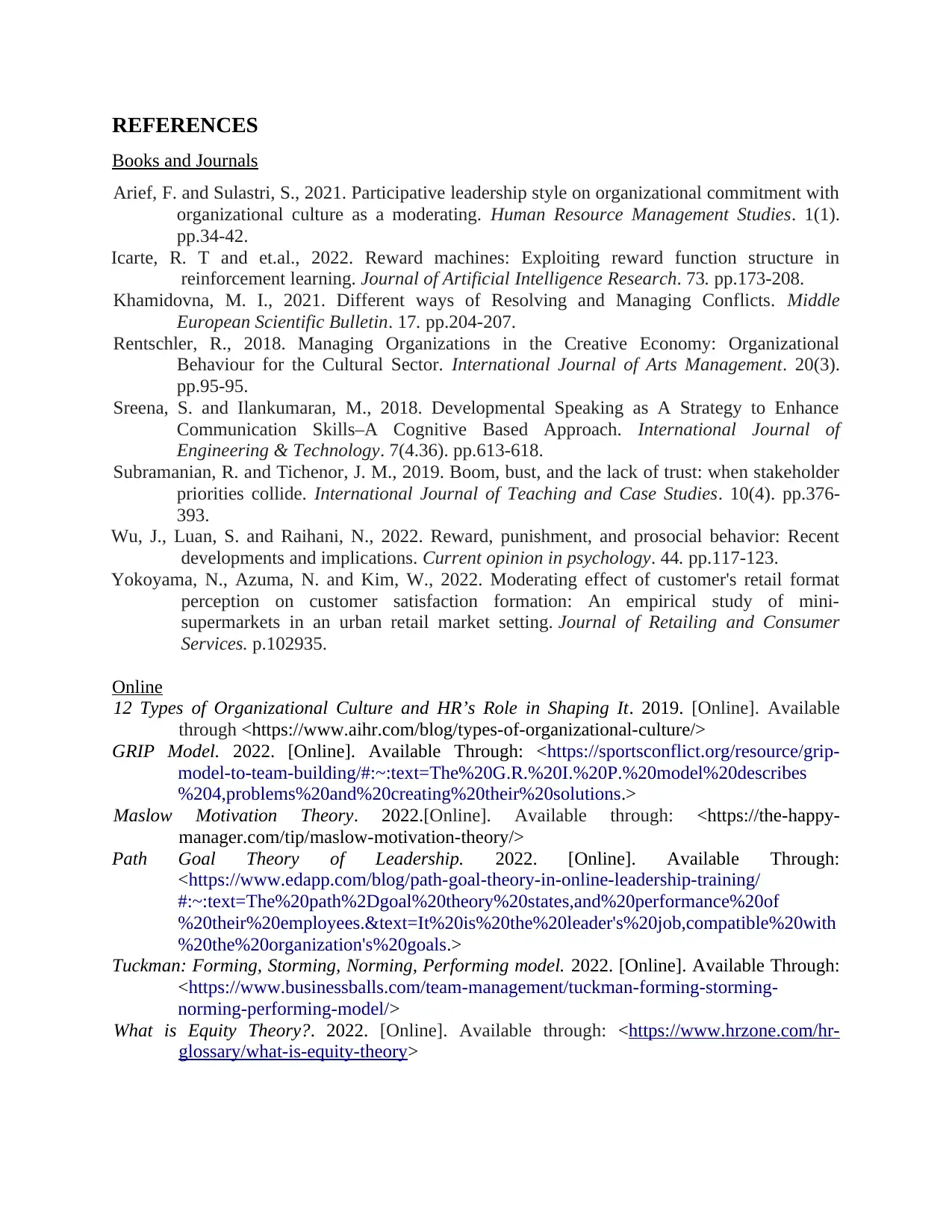
REFERENCES
Books and Journals
Arief, F. and Sulastri, S., 2021. Participative leadership style on organizational commitment with
organizational culture as a moderating. Human Resource Management Studies. 1(1).
pp.34-42.
Icarte, R. T and et.al., 2022. Reward machines: Exploiting reward function structure in
reinforcement learning. Journal of Artificial Intelligence Research. 73. pp.173-208.
Khamidovna, M. I., 2021. Different ways of Resolving and Managing Conflicts. Middle
European Scientific Bulletin. 17. pp.204-207.
Rentschler, R., 2018. Managing Organizations in the Creative Economy: Organizational
Behaviour for the Cultural Sector. International Journal of Arts Management. 20(3).
pp.95-95.
Sreena, S. and Ilankumaran, M., 2018. Developmental Speaking as A Strategy to Enhance
Communication Skills–A Cognitive Based Approach. International Journal of
Engineering & Technology. 7(4.36). pp.613-618.
Subramanian, R. and Tichenor, J. M., 2019. Boom, bust, and the lack of trust: when stakeholder
priorities collide. International Journal of Teaching and Case Studies. 10(4). pp.376-
393.
Wu, J., Luan, S. and Raihani, N., 2022. Reward, punishment, and prosocial behavior: Recent
developments and implications. Current opinion in psychology. 44. pp.117-123.
Yokoyama, N., Azuma, N. and Kim, W., 2022. Moderating effect of customer's retail format
perception on customer satisfaction formation: An empirical study of mini-
supermarkets in an urban retail market setting. Journal of Retailing and Consumer
Services. p.102935.
Online
12 Types of Organizational Culture and HR’s Role in Shaping It. 2019. [Online]. Available
through <https://www.aihr.com/blog/types-of-organizational-culture/>
GRIP Model. 2022. [Online]. Available Through: <https://sportsconflict.org/resource/grip-
model-to-team-building/#:~:text=The%20G.R.%20I.%20P.%20model%20describes
%204,problems%20and%20creating%20their%20solutions.>
Maslow Motivation Theory. 2022.[Online]. Available through: <https://the-happy-
manager.com/tip/maslow-motivation-theory/>
Path Goal Theory of Leadership. 2022. [Online]. Available Through:
<https://www.edapp.com/blog/path-goal-theory-in-online-leadership-training/
#:~:text=The%20path%2Dgoal%20theory%20states,and%20performance%20of
%20their%20employees.&text=It%20is%20the%20leader's%20job,compatible%20with
%20the%20organization's%20goals.>
Tuckman: Forming, Storming, Norming, Performing model. 2022. [Online]. Available Through:
<https://www.businessballs.com/team-management/tuckman-forming-storming-
norming-performing-model/>
What is Equity Theory?. 2022. [Online]. Available through: <https://www.hrzone.com/hr-
glossary/what-is-equity-theory>
Books and Journals
Arief, F. and Sulastri, S., 2021. Participative leadership style on organizational commitment with
organizational culture as a moderating. Human Resource Management Studies. 1(1).
pp.34-42.
Icarte, R. T and et.al., 2022. Reward machines: Exploiting reward function structure in
reinforcement learning. Journal of Artificial Intelligence Research. 73. pp.173-208.
Khamidovna, M. I., 2021. Different ways of Resolving and Managing Conflicts. Middle
European Scientific Bulletin. 17. pp.204-207.
Rentschler, R., 2018. Managing Organizations in the Creative Economy: Organizational
Behaviour for the Cultural Sector. International Journal of Arts Management. 20(3).
pp.95-95.
Sreena, S. and Ilankumaran, M., 2018. Developmental Speaking as A Strategy to Enhance
Communication Skills–A Cognitive Based Approach. International Journal of
Engineering & Technology. 7(4.36). pp.613-618.
Subramanian, R. and Tichenor, J. M., 2019. Boom, bust, and the lack of trust: when stakeholder
priorities collide. International Journal of Teaching and Case Studies. 10(4). pp.376-
393.
Wu, J., Luan, S. and Raihani, N., 2022. Reward, punishment, and prosocial behavior: Recent
developments and implications. Current opinion in psychology. 44. pp.117-123.
Yokoyama, N., Azuma, N. and Kim, W., 2022. Moderating effect of customer's retail format
perception on customer satisfaction formation: An empirical study of mini-
supermarkets in an urban retail market setting. Journal of Retailing and Consumer
Services. p.102935.
Online
12 Types of Organizational Culture and HR’s Role in Shaping It. 2019. [Online]. Available
through <https://www.aihr.com/blog/types-of-organizational-culture/>
GRIP Model. 2022. [Online]. Available Through: <https://sportsconflict.org/resource/grip-
model-to-team-building/#:~:text=The%20G.R.%20I.%20P.%20model%20describes
%204,problems%20and%20creating%20their%20solutions.>
Maslow Motivation Theory. 2022.[Online]. Available through: <https://the-happy-
manager.com/tip/maslow-motivation-theory/>
Path Goal Theory of Leadership. 2022. [Online]. Available Through:
<https://www.edapp.com/blog/path-goal-theory-in-online-leadership-training/
#:~:text=The%20path%2Dgoal%20theory%20states,and%20performance%20of
%20their%20employees.&text=It%20is%20the%20leader's%20job,compatible%20with
%20the%20organization's%20goals.>
Tuckman: Forming, Storming, Norming, Performing model. 2022. [Online]. Available Through:
<https://www.businessballs.com/team-management/tuckman-forming-storming-
norming-performing-model/>
What is Equity Theory?. 2022. [Online]. Available through: <https://www.hrzone.com/hr-
glossary/what-is-equity-theory>
1 out of 13
Related Documents
Your All-in-One AI-Powered Toolkit for Academic Success.
+13062052269
info@desklib.com
Available 24*7 on WhatsApp / Email
![[object Object]](/_next/static/media/star-bottom.7253800d.svg)
Unlock your academic potential
© 2024 | Zucol Services PVT LTD | All rights reserved.





